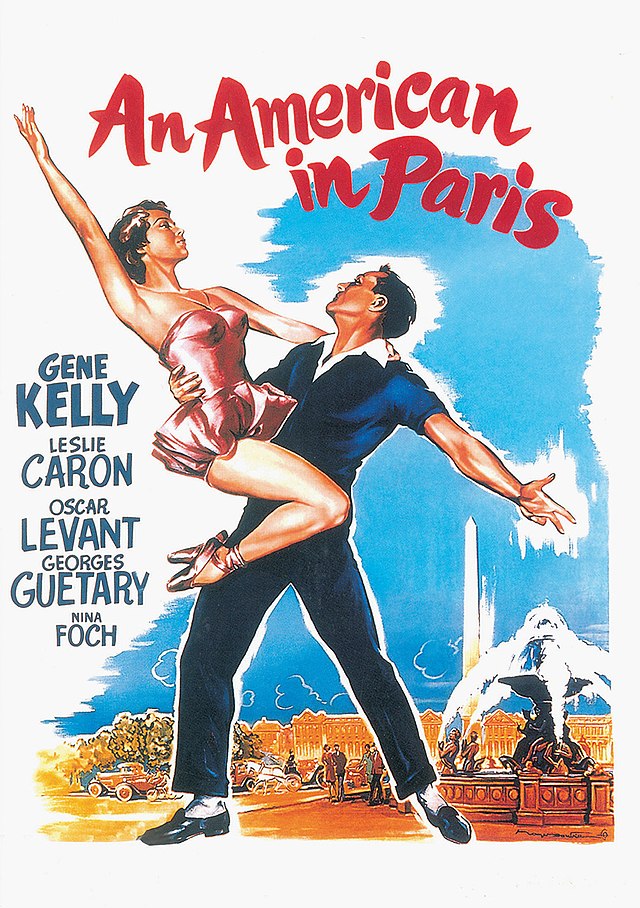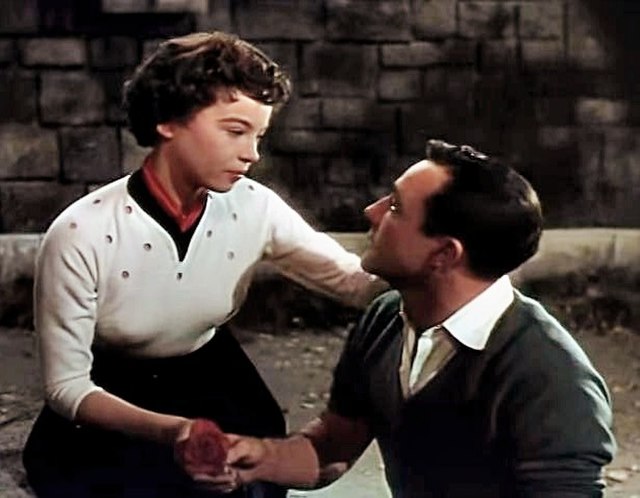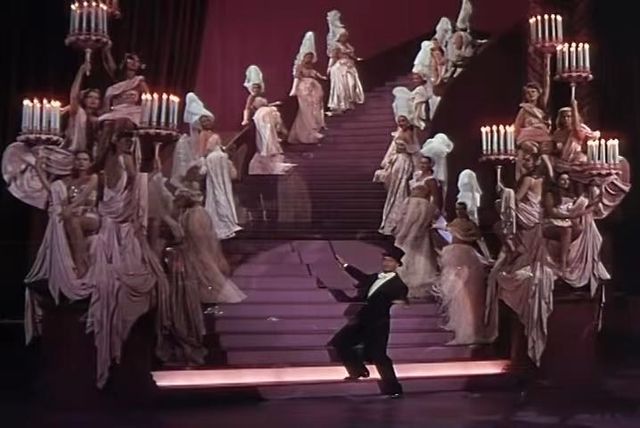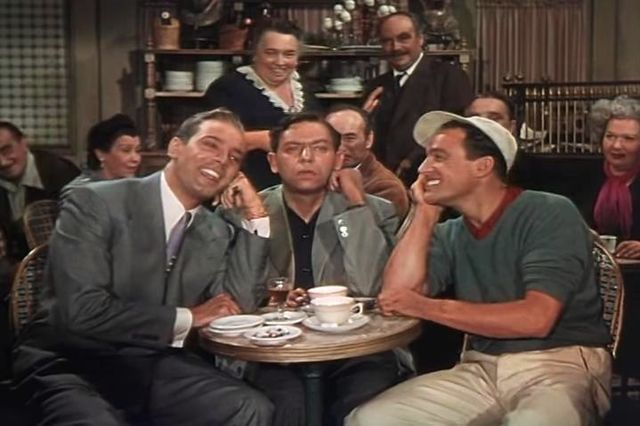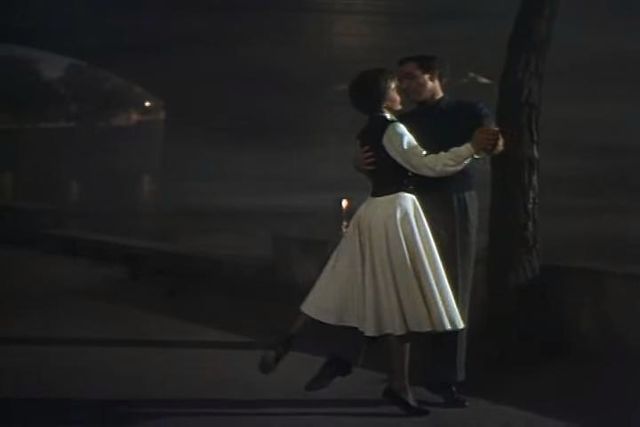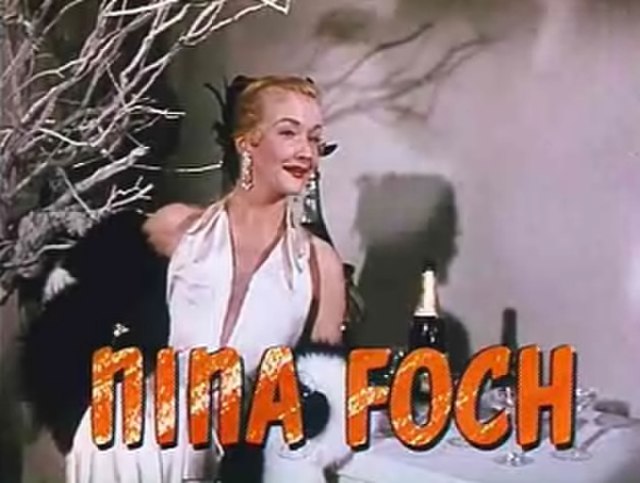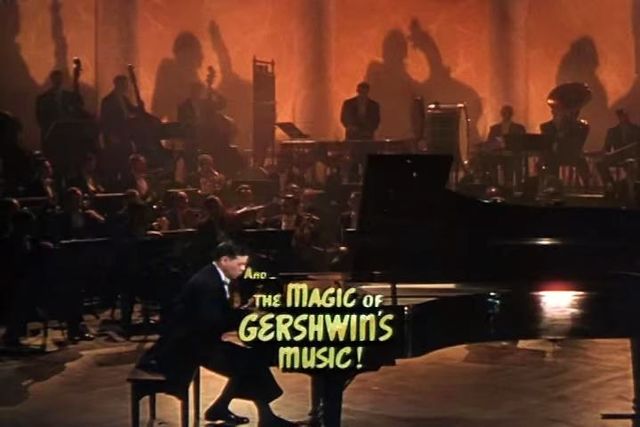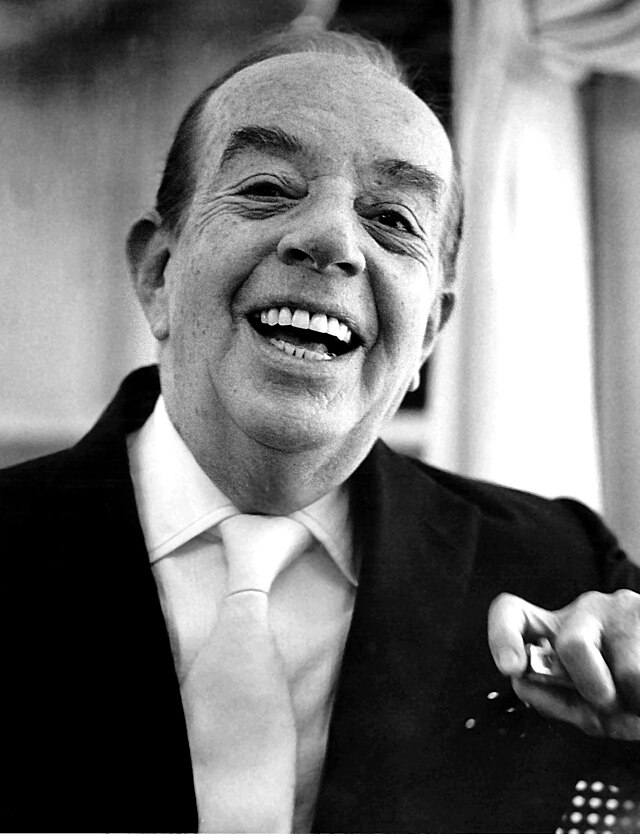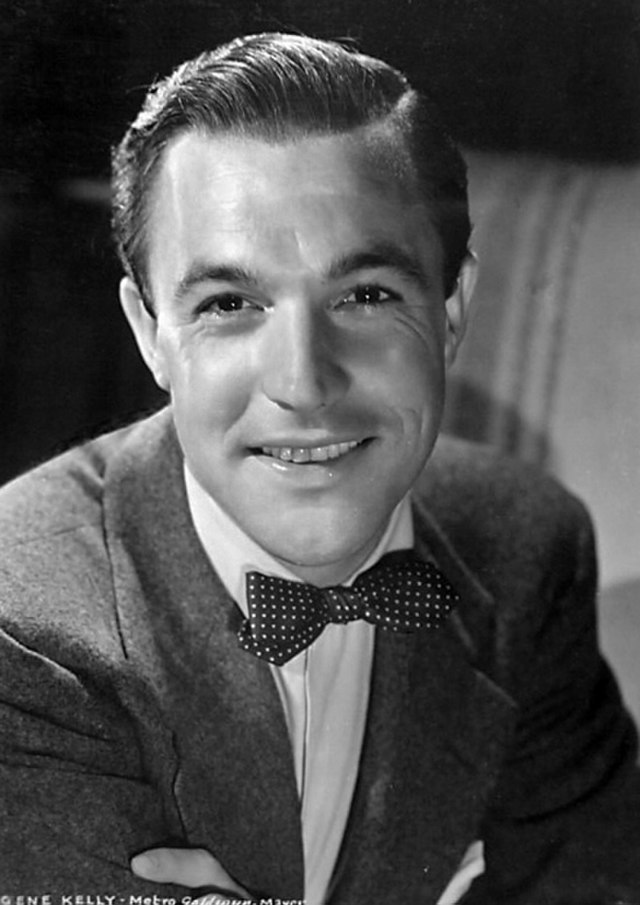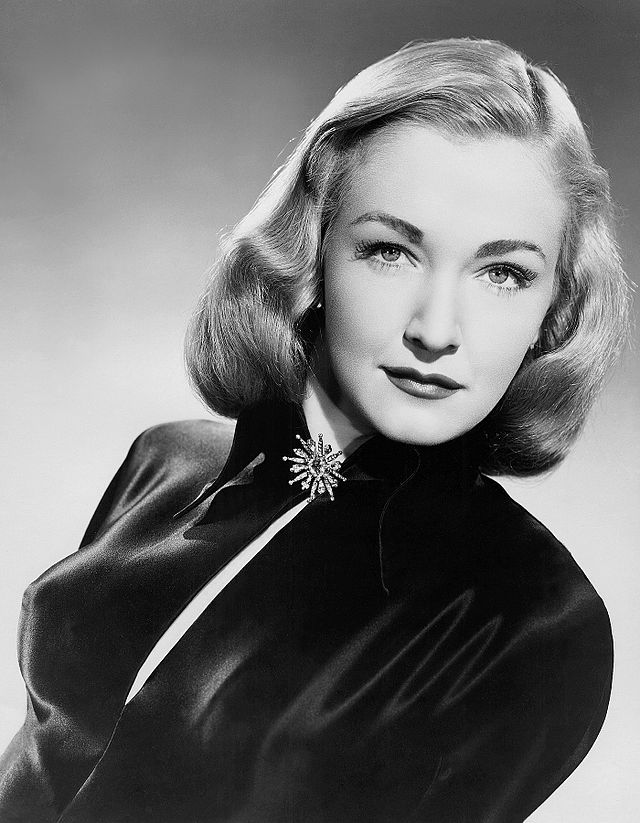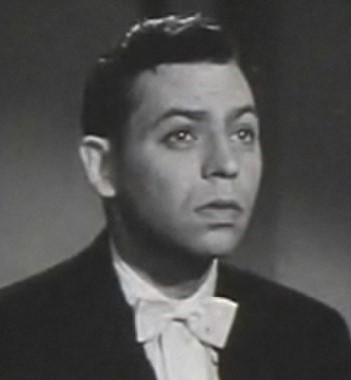An American in Paris - 1951
back| Released by | Metro-Goldwyn-Mayer |
| Director | Vincente Minnelli |
| Producer | Arthur Freed |
| Script | Alan Jay Lerner |
| Cinematography | Alfred Gilks (with John Alton, uncredited) |
| Music by | George Gershwin (songs by Ira Gershwin) |
| Running time | 113 minutes |
| Film budget | $2.7 million |
| Box office sales | $7 million |
| Main cast | Gene Kelly - Leslie Caron - Oscar Levant - Nina Foch |
An American in Paris
A Vibrant Celebration of Love, Art, and Dance
An American in Paris (1951), directed by Vincente Minnelli, is a vibrant musical about Jerry Mulligan (Gene Kelly), an American ex-G.I. living in post-war Paris who falls in love with a French woman, Lise (Leslie Caron).
The film’s artistic centerpiece is its 17-minute ballet sequence, blending dance, music, and French Impressionist art, set to George Gershwin’s score.
The film was a groundbreaking fusion of music, choreography, and visual artistry, earning six Academy Awards, including Best Picture.
Related
An American in Paris – 1951
Summary
Set in post-World War II Paris, An American in Paris follows the story of Jerry Mulligan (Gene Kelly), an ex-G.I. who stays in Paris after the war to pursue his dream of becoming a painter. He lives a bohemian life in the heart of the city, scraping by financially but driven by his artistic ambition. Jerry is affable and carefree, charming those around him with his optimism and talent.
One of Jerry's friends is Adam Cook (Oscar Levant), a cynical pianist and composer who also struggles to make ends meet. Together with Henri Baurel (Georges Guétary), a French singer and entertainer who is more successful, the three men form a small but tight-knit group. Henri is unaware of Adam's unrequited feelings for the beautiful Lise Bouvier (Leslie Caron), a delicate and graceful French girl to whom Henri is secretly engaged.
Jerry's fortunes take a turn when he catches the eye of Milo Roberts (Nina Foch), a wealthy American heiress and art patroness who offers to support his painting career. While Milo clearly has romantic intentions, Jerry accepts her help because it gives him the opportunity to focus on his art.
Jerry's world is further complicated when he meets Lise at a café and instantly falls in love with her. What follows is a bittersweet love triangle: Jerry is smitten with Lise but unaware of her engagement to Henri, while Lise is torn between her sense of duty to Henri, who protected her during the war, and her growing love for Jerry.
As Jerry's feelings for Lise deepen, he becomes increasingly disillusioned with Milo, who grows jealous of Lise and Jerry's connection. A climactic moment occurs at a grand costume ball where the emotional tensions of the characters come to a head. Jerry, heartbroken by the realization that Lise will marry Henri, gives a moving soliloquy where he contemplates the impossibility of his love for her.
The film culminates in an elaborate, 17-minute ballet sequence that transports Jerry and Lise through a dreamlike vision of Paris. This segment, set to George Gershwin's orchestral composition "An American in Paris," showcases Minnelli’s signature style—melding vibrant colors, dance, and fantasy into a lush, romantic fantasy. After the dream ends, Lise, having left Henri, runs into Jerry’s arms, and the two finally unite in love.
Analysis
An American in Paris is a quintessential example of the Hollywood musical, blending lavish choreography, a stunning use of color, and classical music into a seamless narrative that elevates the romantic and artistic themes of the story. Vincente Minnelli’s direction is key to the film's artistic success, as he creates a vibrant visual world that feels both real and dreamlike. Paris is depicted as a city of beauty, love, and art—a kind of playground for creativity, where the characters’ personal and artistic desires intertwine.
Gene Kelly, who also choreographed the dance sequences, brings a dynamic and physical energy to his role. His character, Jerry, is the embodiment of American optimism and perseverance, contrasting with the more subdued and reflective Adam and Henri. Kelly’s choreography is both athletic and elegant, particularly in the film's finale, where the 17-minute ballet synthesizes his vision of Paris, infusing classical ballet with elements of jazz and modern dance.
The ballet sequence is the most celebrated part of the film. It's an ambitious and abstract expression of the characters' inner emotions, told purely through movement, color, and music. The dreamscape created in this sequence references iconic works of French art, including the paintings of Toulouse-Lautrec and Renoir. This scene is Minnelli’s triumph, showing his ability to turn visual art into cinematic movement. It elevates the film beyond a simple love story into an exploration of artistic expression itself.
At the heart of the film is its musical score, built around the works of George and Ira Gershwin. The music enhances both the joyous and melancholic moments, from the energetic tap numbers to the more introspective piano performances. Gershwin’s "Rhapsody in Blue" and "An American in Paris" blend classical composition with jazz influences, reflecting the film’s mixture of American and European artistic traditions.
Thematically, the film is about the tension between passion and duty. Lise’s internal struggle between her loyalty to Henri and her feelings for Jerry mirrors the post-war dilemmas of choosing between comfort and emotional truth. Similarly, Jerry's acceptance of Milo's patronage for financial security clashes with his true love for Lise, revealing a broader commentary on the compromises that artists often make in the pursuit of their dreams.
The film is also a meditation on art itself. Jerry's struggle as a painter, Adam's unfulfilled musical ambitions, and the elaborate ballet sequence all serve to reflect on the nature of creative expression. In this sense, An American in Paris is not just about romantic love, but about the love of art and the way it shapes human experience.
Despite the complex emotional landscape of the characters, the film is ultimately optimistic. Jerry and Lise’s final union is not just a romantic triumph but a symbol of the ability to break free from societal constraints and follow one’s heart.
Classic Trailer An American in Paris
Full Cast
· Gene Kelly as Jerry Mulligan
· Leslie Caron as Lise Bouvier
· Oscar Levant as Adam Cook
· Georges Guétary as Henri Baurel
· Nina Foch as Milo Roberts
· Thelma Charleton as Therese
· Henri Letondal as Georges Mattieu
· Eugene Borden as Cafe Headwaiter
· Madge Blake as Kay Jansen
· Ann Codee as Old Woman
· Noel Neill as American Girl (uncredited)
· Anna Q. Nilsson as American Art Student (uncredited)
· John Eldredge as Mr. Jansen (uncredited)
Vincente Minnelli’s Direction
Vincente Minnelli's direction of An American in Paris (1951) is widely regarded as one of the finest examples of his work in the Hollywood musical genre. His approach combines an acute visual sensitivity with a deep understanding of how to integrate music, dance, and storytelling into a cohesive cinematic experience. Minnelli's mastery lies in his ability to elevate a simple romantic narrative into a visually dynamic and emotionally resonant piece of art.
Visual Style and Use of Color:
Minnelli was known for his vibrant use of color, and An American in Paris is a testament to his skill in creating visually stunning, painterly compositions. He employs color not just for aesthetic beauty but as a tool to express emotion and mood. Throughout the film, the use of rich, saturated hues—especially in the dreamlike ballet sequence—enhances the romantic and artistic themes of the story. Minnelli drew from the Impressionist art of Paris, using vivid colors and light to mirror the fluidity and warmth of the city and the emotional depth of the characters.
The grand finale, the 17-minute ballet sequence, is one of the most iconic examples of Minnelli’s visual storytelling. It’s an extended, wordless segment that feels almost surreal in its execution, blending dance, music, and art into a pure cinematic fantasy. Minnelli’s references to French painters like Toulouse-Lautrec, Dufy, and Renoir in the set designs and choreography serve to ground the fantasy in the culture of Paris, while simultaneously elevating the film into a realm of heightened artistic expression. His use of set design, lighting, and color creates a dreamlike landscape that feels alive with emotion and movement, making this sequence a hallmark of his creative vision.
Integration of Music and Dance:
As a director, Minnelli was adept at integrating music and dance in a way that felt natural and organic to the storytelling. In An American in Paris, the musical numbers are not simply added entertainment but are woven seamlessly into the narrative fabric of the film. Minnelli has an instinctive understanding of how music can propel the plot forward and deepen character development.
For instance, Gene Kelly’s dance sequences are not just showcases of athleticism and grace, but they also reveal key aspects of Jerry Mulligan’s personality—his optimism, charm, and underlying frustrations. In particular, Minnelli’s direction allows the final ballet to become a non-verbal emotional climax, where the unresolved tension between Jerry and Lise finds expression through movement. The dreamlike structure of the ballet makes it both a psychological exploration and a metaphorical representation of Jerry’s inner world.
Minnelli also uses George Gershwin's music, particularly in the film’s climactic scenes, to emphasize the melding of American and Parisian influences. The combination of Gershwin’s jazz-inspired compositions and the classical ballet speaks to the film’s thematic exploration of cultural intersections, with Minnelli using music as a bridge between the two worlds.
Thematic Depth and Emotional Subtext:
Though An American in Paris is a romance at its core, Minnelli's direction provides the film with a layer of thematic and emotional complexity that transcends the traditional musical format. The tension between love and duty, the conflict between artistic integrity and financial support, and the clash of American and European cultural values are subtly woven into the film.
Minnelli allows the characters’ internal conflicts to emerge naturally. Lise’s struggle between her sense of obligation to Henri and her love for Jerry is treated with nuance and compassion. Minnelli doesn’t rush the resolution of this love triangle; instead, he allows it to simmer beneath the surface, adding depth to the seemingly lighthearted musical scenes.
Similarly, Jerry’s internal battle between accepting Milo’s financial support and pursuing his own artistic vision reflects broader questions about the sacrifices artists must make for success. Through Minnelli’s direction, the film becomes a meditation on the relationship between art and commerce, and how love and creativity often intersect with these larger forces.
Balancing Fantasy and Realism:
One of Minnelli’s greatest strengths is his ability to balance the fantastical elements of a musical with grounded, human emotions. In An American in Paris, Paris is both a real, tangible city and an idealized fantasy world. The film begins with a somewhat realistic depiction of post-war Paris—bustling cafes, street vendors, and struggling artists—but gradually evolves into a more fantastical and dreamlike vision of the city. Minnelli manages this transition smoothly, using fantasy as a way to externalize the characters’ emotions while keeping their emotional journeys grounded in realism.
The film's fantasy sequences, particularly the ballet, are extensions of the characters' psychological states. Jerry’s dream of Paris, as expressed in the ballet, is larger than life, vibrant, and full of movement, reflecting his inner longing for love and artistic success. The fluidity between reality and fantasy is a hallmark of Minnelli’s style, and in An American in Paris, it enhances the film's emotional impact, allowing the audience to experience Jerry's joy, frustration, and desire in a highly stylized, visually poetic way.
Pacing and Narrative Structure:
Minnelli's direction ensures that the film's pacing never drags, despite its long ballet sequence and musical interludes. The story is structured around key musical numbers that serve as both narrative high points and character explorations. Each sequence is carefully timed to reveal something new about the characters or their relationships, and Minnelli builds the tension toward the final resolution without losing the audience’s interest. His use of humor, particularly through Oscar Levant’s sardonic character Adam, balances the film’s romantic and emotional moments, giving it a lightness and playfulness that prevents the narrative from becoming overly sentimental.
Legacy and Influence:
Vincente Minnelli’s direction of An American in Paris set a new standard for the Hollywood musical. His ability to blend artistic visuals, music, and dance into a single, harmonious whole redefined what the genre could achieve. Minnelli’s influence can be seen in later musicals, particularly in films that emphasize the integration of music with visual storytelling, such as La La Land (2016). His direction in An American in Paris turned what could have been a simple romantic comedy into a work of art that explores the intersection of love, creativity, and the pursuit of dreams.
In conclusion, Vincente Minnelli’s direction in An American in Paris is a masterclass in visual and emotional storytelling. His use of color, music, and dance creates a lush, dreamlike world that enhances the characters’ emotional journeys. His ability to balance fantasy and realism, combined with his meticulous attention to detail, makes An American in Paris not only one of the greatest musicals of its time but also a lasting cinematic achievement.
Illustrious Performance of Gene Kelly
ene Kelly’s performance in An American in Paris (1951) stands as one of the defining achievements of his illustrious career, blending his unique talents as a dancer, actor, and choreographer into a captivating and multifaceted portrayal. As Jerry Mulligan, an ex-G.I. turned struggling painter in post-war Paris, Kelly brings a vibrant, infectious energy to the screen, embodying both the physicality and charm that made him one of Hollywood’s most beloved musical stars. His performance is a tour de force of dance, emotional depth, and effortless charisma.
Physicality and Dance:
Gene Kelly's performance is first and foremost a celebration of movement. His background in dance is the foundation of the character Jerry, and throughout the film, Kelly uses his body to express everything from exuberant joy to quiet longing. His physicality is evident in every frame—whether he’s executing intricate ballet movements or performing dynamic, athletic tap routines, Kelly's grace and control are unmatched.
Kelly’s choreography in the film is tailored to his strengths as a dancer. His movements are both precise and fluid, showcasing his ability to blend styles. In the famous "I Got Rhythm" number, Kelly dances with a group of Parisian children, mixing tap, jazz, and playful gestures that capture Jerry’s carefree spirit. His energy is contagious, and the sequence becomes a vibrant display of joy and spontaneity. Kelly has an ability to make even the most technically demanding routines appear effortless, and his dancing in An American in Paris reflects his innovative approach to choreography—infusing classical dance forms with American styles like jazz and tap, resulting in a uniquely dynamic performance.
The pinnacle of Kelly’s performance comes in the film's climactic 17-minute ballet sequence, set to George Gershwin’s An American in Paris. In this segment, Kelly transitions from playful dance routines to a more introspective, dreamlike exploration of Jerry's emotional turmoil. The ballet is a showcase not only of Kelly’s physical prowess but also his capacity to convey deep emotional complexity through movement. His dance tells a story of unfulfilled love, longing, and passion, all without a single spoken word. The sweeping, lyrical choreography reflects Jerry’s inner world—his aspirations, frustrations, and romantic desires—allowing Kelly to convey an extraordinary range of emotion purely through dance.
Charm and Charisma:
Gene Kelly’s inherent charisma is a central element of his portrayal of Jerry Mulligan. From the moment he appears on screen, Kelly radiates a confident, easygoing charm that instantly endears him to the audience. Jerry is a character who embodies American optimism—carefree, ambitious, and relentlessly hopeful—and Kelly’s performance captures this spirit with warmth and sincerity. Whether Jerry is bantering with friends, wooing Lise, or playfully teasing Milo, Kelly’s natural charm makes the character irresistibly likable.
Kelly’s interactions with the other characters are a testament to his ability to create chemistry on screen. His scenes with Leslie Caron (Lise Bouvier) are filled with romantic tension and tenderness, as Jerry’s playful pursuit of Lise gradually gives way to a more sincere and vulnerable longing. Kelly’s natural rapport with Caron is evident in their dance sequences together, where their movements are perfectly synchronized, creating an unspoken intimacy between their characters. Despite the age difference between Kelly and Caron, their on-screen romance feels genuine and heartfelt, a testament to Kelly’s ability to adapt his performance to suit his partner.
In contrast, Kelly’s interactions with Nina Foch’s Milo Roberts, the wealthy art patroness who harbors feelings for Jerry, are marked by a subtle tension. Kelly plays Jerry as initially oblivious to Milo’s romantic interest, and when he finally becomes aware of it, his demeanor shifts from carefree to uncomfortable. This dynamic reveals Kelly’s skill at navigating the more complex emotional undercurrents of the story, balancing Jerry’s romantic idealism with the more pragmatic concerns of his financial situation.
Emotional Depth and Vulnerability:
While Gene Kelly is best known for his exuberant dance numbers, his performance in An American in Paris also demonstrates his ability to convey emotional vulnerability. Jerry is not just a happy-go-lucky artist; he’s a man grappling with real emotional conflict. As the film progresses, we see Jerry’s carefree nature give way to a deeper emotional struggle as he falls in love with Lise, unaware of her commitment to Henri.
Kelly’s portrayal of Jerry’s emotional journey is nuanced. He expresses the character’s frustration, longing, and heartache in ways that feel authentic and relatable. In particular, the scene where Jerry learns that Lise is engaged to Henri is a turning point in the film, and Kelly handles it with remarkable restraint. Rather than resorting to melodrama, he lets the sadness settle in his expressions and body language, allowing the audience to feel Jerry’s disappointment and confusion without excessive dialogue. His speech at the costume ball, where he contemplates the impossibility of his love for Lise, is delivered with poignant introspection, revealing a side of Jerry that is more reflective and self-aware than his usual jovial persona.
The final ballet sequence, where Jerry envisions a romantic reunion with Lise in a fantasy Paris, showcases Kelly’s emotional depth. As Jerry dances through this imagined world, we see the full extent of his love for Lise and the pain of their separation. Kelly’s movements here are softer, more lyrical, reflecting the vulnerability of a man who has laid bare his heart. This sequence allows Kelly to transcend the role of a simple romantic lead and embody a character whose inner life is as rich and complex as his outward charisma.
Innovation and Legacy:
Gene Kelly’s performance in An American in Paris is not only a personal triumph but also a landmark in the history of Hollywood musicals. As the film’s choreographer, Kelly pushed the boundaries of what dance in cinema could achieve. He fused ballet with jazz, modern dance, and tap, creating a style that was distinctly American while also paying homage to European classical traditions. Kelly’s influence can be seen in how he made dance an integral part of the storytelling, not merely an entertaining diversion. His use of dance to explore character psychology and emotion paved the way for future musicals to incorporate more sophisticated choreography as a narrative tool.
Kelly’s physicality, charisma, and emotional depth in this role are part of what made him one of the most iconic figures in film history. He wasn’t just a dancer; he was a storyteller, and in An American in Paris, he tells Jerry’s story through every movement, every step, and every glance. His combination of athleticism, grace, and emotional sensitivity remains unparalleled in the world of musical cinema.
Notable Quotes from the Movie
· Jerry Mulligan (Gene Kelly):
“Back home, everyone said I didn't have any talent. They might be saying the same thing over here, but it sounds better in French.”
This quote encapsulates Jerry's carefree, self-deprecating attitude and his pursuit of his art in Paris, where he hopes to escape the judgments he faced in America.
· Milo Roberts (Nina Foch):
“What gets me is, I don't know how I fit in with you. How you feel about me. Oh, I know you like me, and, of course, I like you. But that's not enough, is it?”
Milo’s insecurity surfaces here, revealing her complicated feelings for Jerry and her realization that their relationship is built on unequal emotional footing.
· Jerry Mulligan (Gene Kelly):
“This is Paris. And I'm an American who lives here. My name is Jerry Mulligan, and I'm an ex-GI. In 1945 when the Army told me to find a place to live, I stayed on. And I'll tell you why—I’m a painter.”
This opening narration from Jerry establishes his identity as an American expatriate in Paris, setting the tone for the film and introducing his passion for art.
· Henri Baurel (Georges Guétary):
“Lise was just a child when the war began. The day she was going to leave Paris, she learned that her parents had been killed. She had nowhere to go, so I took care of her. I became very fond of her. She loved me, too, in a way.”
Henri explains his deep bond with Lise, highlighting the emotional complexities of their relationship, which goes beyond simple romance to one rooted in gratitude and obligation.
· Adam Cook (Oscar Levant):
“It's not like one of those French paintings you hang on the wall — you know, like, all bunched up, in a gold frame. It’s the real Paris.”
Adam’s cynical and witty character is often the voice of realism in the film, and this quote reflects his ability to cut through romanticized ideas with sharp humor.
· Jerry Mulligan (Gene Kelly):
“I'm a painter, all right. I don't know why I was born. And I don't know why I’m living. I paint because I like it and I can make a living. But I don't know, is that enough?”
This introspective line reveals Jerry’s deeper struggle with the meaning of his art and existence, showing that beneath his cheerful exterior, he wrestles with existential questions.
· Lise Bouvier (Leslie Caron):
“Maybe Paris has a way of making people forget.”
Lise’s comment speaks to the transformative power of Paris, a city that holds the potential for both escape and reinvention, but also reflects her own internal conflict in trying to reconcile her past and her feelings for Jerry.
· Jerry Mulligan (Gene Kelly):
“How long have you known him? How long have you been in love with him? How long have you been pretending you weren’t in love with me?”
Jerry confronts Lise with this impassioned line, capturing the emotional intensity of his feelings for her and the painful confusion of the love triangle.
Classic Scenes from An American in Paris
An American in Paris is filled with iconic and memorable scenes that have become classics of film history. Vincente Minnelli's direction, Gene Kelly's choreography, and the film's vibrant use of color and music all contribute to the creation of some of the most visually and emotionally engaging moments in cinema. Here are some of the standout classic scenes from the movie:
The Opening Sequence:
In the film's opening scene, Jerry Mulligan (Gene Kelly) introduces himself and his life in Paris. Set against a picturesque backdrop of post-war Paris, Jerry explains why he stayed in the city after the war to pursue his dream of being a painter. The scene sets the tone for the entire film, highlighting Paris as both a real city and a romanticized playground for creativity and dreams. Kelly’s charming narration and the playful energy of the setting instantly immerse the audience in the bohemian spirit of the film.
"I Got Rhythm" (Song and Dance Sequence):
In one of the most joyous and energetic scenes, Gene Kelly’s Jerry performs a playful dance routine with a group of French children to the tune of Gershwin’s "I Got Rhythm." This scene is quintessential Gene Kelly, showcasing his athleticism, charisma, and dance skills. Kelly uses everyday objects like lampposts and railings in his choreography, blending his love for tap dance with a sense of spontaneity and fun. The scene perfectly captures Jerry’s carefree attitude and zest for life, and it’s a quintessential example of Kelly’s innovative use of dance in film.
"Our Love is Here to Stay" (Seine River Dance):
One of the most romantic scenes in the film takes place by the Seine River, where Jerry and Lise (Leslie Caron) express their love for each other in a beautifully understated song and dance sequence. Set to the song "Our Love is Here to Stay," the scene is bathed in a soft, golden light, creating an intimate atmosphere. The chemistry between Kelly and Caron is palpable as they engage in a delicate pas de deux, blending ballet and ballroom styles. The scene highlights Minnelli’s ability to use dance as a vehicle for expressing the characters’ emotions and the growing love between Jerry and Lise.
Oscar Levant's Fantasy Piano Sequence ("Concerto in F"):
Oscar Levant’s character, Adam Cook, is the film’s witty, cynical sidekick, and he gets his own dream sequence that is both humorous and impressive. In this scene, Adam imagines himself as a one-man orchestra, playing George Gershwin’s "Concerto in F" at the piano. The camera cleverly multiplies Levant’s image so that he appears as every musician in the orchestra, conducting and playing every instrument. It’s a lighthearted but visually inventive sequence that showcases Levant’s piano skills while also adding a touch of surreal humor to the film.
The Costume Ball Scene:
This scene is a pivotal emotional turning point in the film. Jerry and Lise attend a lavish costume ball, where the tensions of the love triangle between Jerry, Lise, and Henri Baurel (Georges Guétary) come to a head. The costumes and setting are extravagant, adding a sense of heightened drama to the situation. During the party, Jerry makes a passionate declaration of love to Lise, but she is torn between her feelings for him and her loyalty to Henri. The scene is infused with emotional intensity as Jerry realizes that Lise plans to marry Henri, setting up the heartbreak that leads to the final ballet sequence.
The 17-Minute Ballet Finale:
The most famous and celebrated scene in An American in Paris is the climactic 17-minute ballet sequence, set to George Gershwin’s orchestral composition An American in Paris. This wordless, dreamlike sequence is an ambitious blend of dance, art, and music that takes place in Jerry’s imagination after he is heartbroken by Lise’s decision to stay with Henri. The ballet takes the audience on a journey through Jerry’s vision of Paris, referencing famous French artworks and landmarks along the way.
Each segment of the ballet reflects a different emotional state or artistic influence, with the sets and choreography drawing inspiration from artists like Toulouse-Lautrec, Dufy, and Renoir. The vibrant, expressionistic use of color and lighting creates a fantastical version of Paris, with Kelly leading the audience through a visual feast of movement and design. The ballet transitions between different dance styles, from ballet to jazz, and showcases Kelly’s athleticism and grace. Leslie Caron’s performance as Lise in this sequence also stands out, as she matches Kelly’s energy and emotion step for step.
The ballet is a bold and innovative departure from traditional musical numbers, serving as the emotional climax of the film. It encapsulates Jerry’s love for Lise, his longing, and his artistic passion. The scene is often considered one of the greatest achievements in film musicals, and it solidified An American in Paris as a groundbreaking piece of cinema.
The Final Reunion:
After the ballet sequence ends, the film returns to reality, where Lise finally leaves Henri and rushes into Jerry’s arms. The reunion takes place on the same balcony where earlier Jerry had stood heartbroken, gazing out at Paris. The film concludes with a final romantic embrace between Jerry and Lise, set against a backdrop of fireworks—a symbolic gesture of love’s triumph over duty and societal expectations. The scene is simple yet emotionally powerful, bringing the romantic narrative to a satisfying close.
Awards and Recognition
Academy Awards (Oscars) 1952:
The film was a significant success at the Academy Awards, winning six out of eight nominations.
- Wins:
Best Picture – Arthur Freed (Producer)
Best Writing, Story and Screenplay – Alan Jay Lerner
Best Cinematography (Color) – Alfred Gilks and John Alton (uncredited)
Best Art Direction-Set Decoration (Color) – E. Preston Ames, Cedric Gibbons, F. Keogh Gleason, and Edwin B. Willis
Best Costume Design (Color) – Orry-Kelly, Walter Plunkett, and Irene Sharaff
Best Music (Scoring of a Musical Picture) – Johnny Green and Saul Chaplin
- Nominations:
Best Director – Vincente Minnelli
Best Film Editing – Adrienne Fazan
Golden Globe Awards 1952:
- Nominations:
Best Motion Picture – Musical or Comedy
British Academy Film Awards (BAFTA) 1952:
- Nominations:
Best Film from any Source
Cannes Film Festival 1952:
- Wins:
Grand Prize for Vincente Minnelli (though not in the official competition, the film was honored with a special recognition)
New York Film Critics Circle Awards 1951:
- Nominations:
Best Director – Vincente Minnelli
Directors Guild of America (DGA) 1952:
- Nominations:
Outstanding Directorial Achievement in Motion Pictures – Vincente Minnelli
Writers Guild of America (WGA) 1952:
- Wins:
Best Written American Musical – Alan Jay Lerner
National Board of Review 1951:
- Wins:
Top Ten Films of the Year
American Film Institute (AFI) Honors:
- AFI’s 100 Years…100 Movies (1998) – Ranked #68
- AFI’s 100 Years…100 Passions (2002) – Ranked #39
- AFI’s 100 Years of Musicals (2006) – Ranked #9
An American in Paris is widely regarded as one of the greatest musicals of all time, and its award success reflects its impact on both Hollywood and global cinema. Its major victory at the Academy Awards, especially winning Best Picture, cemented its legacy in film history.

